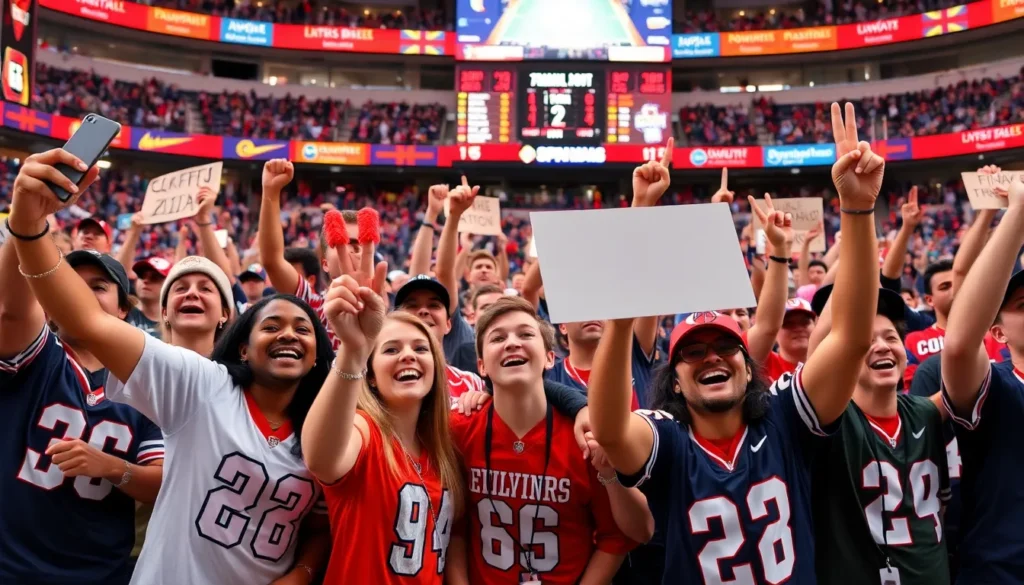In the fast-paced world of sports marketing, keeping up with the latest trends feels like trying to catch a runaway football. From jaw-dropping sponsorship deals to viral social media campaigns, the landscape is ever-changing and full of surprises. It’s a game where creativity meets strategy, and the stakes are higher than ever.
Sports Marketing Current Events
Recent developments in sports marketing illustrate the industry’s dynamic landscape. Brands innovate with partnerships that leverage athletes’ popularity. For instance, Nike’s collaboration with top athletes resulted in campaigns that resonate with diverse audiences. Sponsorship deals continue to escalate, fueling the growth of major leagues and events.
Social media platforms play a crucial role in shaping current marketing strategies. Engaging content goes viral, creating opportunities for brands to connect with fans. TikTok has emerged as a leading platform for sports marketing, allowing brands to reach younger demographics effectively. Teams harness social media for real-time engagement, enhancing overall fan experience.
Sustainability initiatives are gaining momentum within sports marketing. As fans become more environmentally conscious, brands respond with eco-friendly products and campaigns. The incorporation of sustainability resonates well with consumers who prioritize ethical practices. Brands aligning with these values foster stronger connections with their audiences.
Another trend includes the rise of data-driven marketing strategies. Analytics provide insights into consumer behavior, allowing brands to tailor their approaches. By understanding viewer preferences, marketers create more personalized experiences that enhance loyalty. Enhanced targeting capabilities redefine audience segmentation and outreach efforts.
E-sports represents a rapidly growing sector within sports marketing. Major brands invest in sponsorships and events, capitalizing on the massive viewership. Traditional sports teams explore partnerships with e-sports organizations, broadening their reach. Engaging with this demographic offers new revenue streams and fan engagement opportunities.
Overall, sports marketing continues to evolve, driven by trends, technology, and consumer expectations. Staying informed on these developments enables brands to thrive in an increasingly competitive landscape.
Key Trends in Sports Marketing

Recent trends in sports marketing emphasize the significance of technology, creativity, and innovative strategies. Brands adapt rapidly to engage consumers and enhance brand loyalty.
Digital Transformation in Sports
Digital transformation redefines the sports marketing landscape. Brands leverage technology to create immersive fan experiences through virtual reality and augmented reality platforms. Streaming services, such as ESPN+, offer tailored content that caters to diverse audiences. Social media, particularly TikTok, allows rapid dissemination of engaging content, attracting younger demographics. Data analytics drives decision-making, enabling brands to understand consumer behaviors effectively. Personalized marketing campaigns enhance engagement, fostering deeper connections with fans.
The Rise of Influencer Marketing
Influencer marketing gains traction within sports marketing strategies. Athletes, with massive followings, serve as powerful brand ambassadors. Collaborations between brands and influencers showcase products in authentic settings, appealing to targeted audiences. Campaigns featuring relatable content resonate more with consumers, enhancing trust. Partnerships with micro-influencers enable brands to tap into niche markets and engage hyper-targeted fan bases. This trend underscores the evolving role of athletes in brand storytelling, amplifying brand messages while fostering a loyal community.
Recent Case Studies
Recent developments in sports marketing showcase impactful campaigns and valuable takeaways from both successes and failures.
Successful Campaigns in 2023
Innovative strategies marked notable campaigns in 2023. A prime example includes the collaboration between Adidas and several athletes for a sustainability initiative, which generated significant engagement through eco-friendly messaging. Brands are utilizing social media channels effectively, with campaigns on platforms like TikTok attracting millions of views. The popularity of streaming content also increased, as ESPN+ launched a campaign featuring exclusive behind-the-scenes footage, driving subscriptions. Additionally, the partnership between a major sports league and a tech firm introduced augmented reality experiences for fans, culminating in higher attendance and interaction rates at events.
Lessons Learned from Failures
Some marketing campaigns encountered setbacks in 2023. A renowned beverage company faced backlash after its ad campaign misrepresented a key athlete’s involvement, leading to public criticism and diminished trust. Another brand’s sponsorship of an event failed to resonate due to lack of relevance to the target audience. Misalignments between the athlete’s values and the brand’s messaging resulted in consumer confusion, showcasing the importance of authentic partnerships. An attempt to capitalize on a trending meme backfired, illustrating how humor can misfire if not carefully considered. These failures highlight the need for thorough research and alignment with audience expectations in campaign development.
Impact of Social Media on Sports Marketing
Social media significantly shapes sports marketing strategies today. Brands utilize various platforms to engage fans and spread messages rapidly.
Engagement Strategies
Creative content captures audience interest effectively. Brands increasingly leverage short videos and live streams to enhance visibility. TikTok and Instagram Stories allow for quick updates and interactive polls. Collaborations with influencers amplify reach, encouraging authentic connections with followers. Successful campaigns often incorporate fan-generated content, fostering a sense of community among supporters. Marketers benefit from tracking engagement metrics to refine strategies, ensuring relevance in an ever-evolving landscape.
Fan Interaction and Experience
Direct communication with fans enhances loyalty. Brands encourage dialogue through Q&A sessions and live chats, creating a personal touch. Unique fan experiences, such as virtual meet-and-greets with athletes, increase engagement. Augmented reality features allow fans to interact with merchandise in innovative ways. Overall, personalization in marketing creates memorable moments, inviting fans to participate actively in their favorite sports. Utilizing these methods engages consumers more deeply, strengthening brand commitment over time.
Challenges Facing Sports Marketers
Sports marketers encounter several challenges that impact strategy and execution. Understanding these factors becomes essential for adapting to the changing environment.
Economic Factors
Economic factors consistently influence sports marketing. Economic downturns can reduce consumer spending, directly affecting ticket sales and merchandise revenue. Brands often reconsider sponsorship budgets during financial uncertainty, prioritizing high-ROI partnerships. Recent data indicates that brands seek cost-effective marketing solutions to maintain audience engagement while optimizing their spending. Flexibility in planning becomes crucial, enabling marketers to adapt campaigns based on economic shifts. Brands that maintain a strong presence during challenging times can foster greater loyalty among consumers.
Evolving Consumer Behavior
Consumer behavior continues to evolve rapidly, posing challenges for marketers. As consumers increasingly prioritize experiences over material goods, marketers find themselves reassessing traditional strategies. Recent trends show a shift toward immersive and interactive content, reflecting consumers’ desire for engagement. Brands must stay informed on changing preferences to create meaningful connections with fans. Data analytics offers valuable insights into these behaviors, allowing for personalized marketing campaigns that resonate more effectively. Authenticity plays a critical role, as consumers prefer brands that align with their values and interests. Adapting to these evolving behaviors ensures marketers remain relevant in a competitive landscape.
Conclusion
The landscape of sports marketing is continuously evolving and brands must remain agile to thrive. As technology and consumer preferences shift brands are leveraging innovative strategies to enhance engagement and loyalty. The rise of influencer marketing and sustainability initiatives reflects a deeper understanding of audience values and expectations.
Recent case studies underscore the importance of authenticity and thorough research in campaign development. With the right approach brands can create memorable experiences that resonate with fans. Staying informed about current trends and challenges will empower marketers to navigate this dynamic field successfully. The future of sports marketing promises exciting opportunities for those ready to adapt and innovate.

